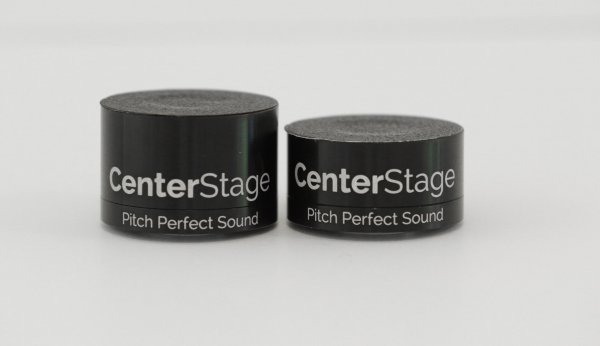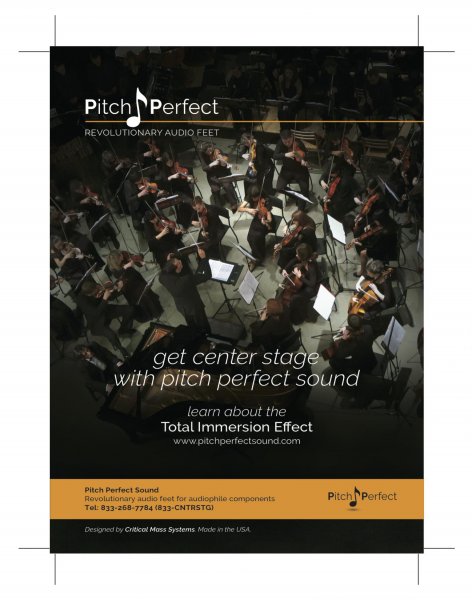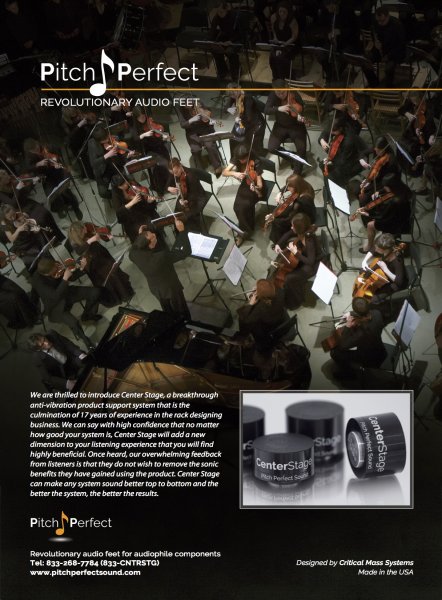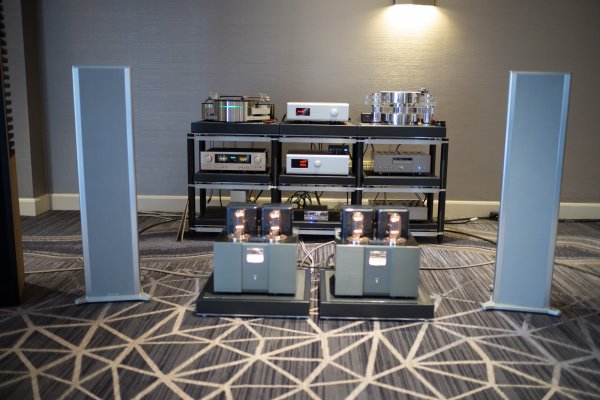I am known through the internet community as “oneobgyn” as in my former life I was an Obstetrician and Gynecologist for 35 years before retiring from active practice in 2007. I have been involved in high end audio throughout most of my adult life and, as a result, in 2010 I founded the very popular and rapidly growing high end audio forum called What’s Best Forum
A lifetime of hard work afforded me the opportunity to put together my dream system. You can see the detailed progression of my listening room on What’s Best Forum at Doctors Orders Part Two http://www.whatsbestforum.com/showt...Steve-Williams&p=191656&viewfull=1#post191656
Like most audiophiles, one of my final steps was finding a great audio rack. And, like most audiophiles I didn’t expect a significant improvement but I went for it nonetheless. I was happy to discover Joe Lavrencik and Critical Mass Systems. I found Joe to not only be bright and articulate but he was so enthused about his products that I decided to redo my entire system in stages with Joe’s CMS Black Diamond racks. Suffice it to say I was stunned by the major improvements in my sound system. Most noticeable was the significant reduction in my noise floor. Before using CMS racks I felt that I was listening from the rear of the orchestra but with my front and back end gear sitting on CMS Black Diamond racks I was transported to the first three rows of the orchestra.
In my mind it just couldn’t get any better than what I was hearing. You guessed it, I was wrong!
Joe and I became friends and in June of 2017 after the L.A. Audio Show, he spent a few days at my house. He told me about something new he felt was the best product he had ever designed. When asked what it was, he said a “foot” for under components and he asked if I wanted to try a few in my system. My first reaction was “oh no, not another foot”, but I agreed.
Before he left, a set of 4 feet went under my CD transport, my preamp, my phono stage and my amps. He warned me that there was a 7-10 day break in. Having owned and/or tried countless audio feet over the years I was very skeptical about everything.
Boy was I in for a shock. For the first 3 days my system sounded worse than terrible. Joe was now back in Chicago and I would call him every day for this first 3 days and tell him I wanted to remove the feet from my components because my system was unlistenable. Joe would say “be patient as the wait will be worth it.” The one thing I have learned about Joe is that when it comes to the design of high end audio racks he is a veritable genius and when he said to be patient, that is what I needed to do.
I am so thrilled that I took his advice. On day 4 my system suddenly had a very pleasant sound. On day 5 the top end of my system was spectacular. By days 6-7 there was such a dramatic change in my mid bass that it had me listening non stop as there was no glare and no fatigue. I was mesmerized.
It wasn’t until days 8-10 however that the true magic of Joe’s “foot” came to life. The deep bass was truly the best I had ever heard in my system and the total integration of the sound literally “snapped into place”. In fact, there was such a profound improvement in the mid bass and deep bass in my speakers that I could turn down the crossover on my JL Audio Fathom subwoofers to the lowest point without any loss of foundation, pace or slam. We all know the acronym PRAT but honestly, I never appreciated pace, rhythm and timing as much as I did with these feet in place.
But there was more! I was not ready for what I heard. Joe, as an audio rack designer for the past 17 years has been working on removing the “wall” at the front plane of the loudspeakers that separates the listener from the musicians. His idea was to lower the noise floor so that the recorded acoustic already found in each song filled the room and immersed the listener in the sound field. This is exactly what I began to hear in my room. Music that I use often for demos had the sound field extending from behind the speakers (as always),and then forward into the room as if there were no speakers there at all. I have never experienced such an audio accomplishment as this in all the years I have been involved in this hobby. On some tracks the sound came so far forward that it seemed to wrap around my head. I became totally immersed in the sound field.
I phoned Joe on day 10 and told him that he was going to have to shoot me to get the feet back because in my mind they were such a dramatic improvement I just couldn’t be without them. I had several further talks with Joe about the product as I felt it was far ahead of anything available today. I convinced Joe that it was important for the every listener to hear and own this product. In fact, I was so excited about this product that I licensed retail distribution from Joe to do that very thing and I now find myself the global distributor for what I call Center Stage. I started a new company for this product and aptly decided to call it “Pitch Perfect Sound”. My new website for Center Stage can be found here www.pitchperfectsound.com
I have a very appropriate tag line as a result, “Get Center Stage with Pitch Perfect Sound”. Appropriate, because this is exactly what the product does.
Having lived with these feet in my system since June of this year I find it totally impossible to listen to my system when they are removed. The sound stage totally collapses into the traditional “listener” / “wall” / “music behind the wall”, old boring way of listening. Music should be an experience, not a song!
Before this product was released I sent many to friends just to make sure the effect was consistent in their systems. They refused to remove them. In fact, they ended up buying them.
Joe continues to OEM the product to manufacturers and he has already had a thousand preorders.
People ask, “how do they work” and included in this website is Joe’s White Paper on the product. He says they act like a catalyst in an energy reaction that changes the equilibrium inside the component. Actually, they reduce thermodynamic entropy which occurs naturally inside the component and, of course, they reduce vibration.
The sonic effect is simply staggering. There is no coloration and definitely no fatigue. The best way I can describe these feet in my system is by offering a comparison. Without the feet I compare my system to a 16 x 9 1080p picture which everyone knows. With the feet, this same 16 x 9 palette becomes a 4K picture with life-like detail and a thrilling “surround sound” component that makes me feel like I’m really there. I become transported from the first three rows in the orchestra to sitting “Center Stage”. Because of this mesmerizing, realistic sonic effect I decided to call the product “Center Stage”. I believe Center Stage is the best product Joe has ever brought to market. Center Stage creates a holographic image in your room that will leave you gasping as you become totally immersed in sound as it moves forward from that imaginary “wall” at the front of one’s speakers.
“I was now transported from those first three rows in the orchestra to sitting “Center Stage”
“Welcome to the magic of center stage”
Welcome to the magic of Center Stage. An American made product by Critical Mass Systems. You don’t have to be a CMS rack owner to hear the effect of sitting Center Stage. It doesn’t matter what your components are sitting on. The overall change is always heard.
There are two versions available. The regular size is 13/16? tall and is recommended for all front end components under 100 pounds. The tall version is 1? high and the shorter version 13/16? . Both are sonically identical and priced the same. The tall size is recommended for use under all amplifiers regardless of the amplifier weight as well as under front end components weighing over 100 pounds.
It is recommended that four feet be used under each component rather than three as the product is voiced best with four feet per component. Both regular size and tall versions sell for $300 USD per foot. Further information about Center Stage can be found in Joe’s White Paper here. http://pitchperfectsound.com/joe-white-paper/

Here is my first full page ad in the November issue of TAS

The response to this product before it has even been released has been simply amazing, so much so I put up another full page ad in the December issue of TAS

So these are the confessions of an audiophile junky and what it took to get me out of 10 years of retirement. This product should be evaluated in every system because the sonic change will simply astound you. I can honestly say that Joe has IMO created a whole new listening experience and I guaranty that you will be immersed in the sound.
A lifetime of hard work afforded me the opportunity to put together my dream system. You can see the detailed progression of my listening room on What’s Best Forum at Doctors Orders Part Two http://www.whatsbestforum.com/showt...Steve-Williams&p=191656&viewfull=1#post191656
Like most audiophiles, one of my final steps was finding a great audio rack. And, like most audiophiles I didn’t expect a significant improvement but I went for it nonetheless. I was happy to discover Joe Lavrencik and Critical Mass Systems. I found Joe to not only be bright and articulate but he was so enthused about his products that I decided to redo my entire system in stages with Joe’s CMS Black Diamond racks. Suffice it to say I was stunned by the major improvements in my sound system. Most noticeable was the significant reduction in my noise floor. Before using CMS racks I felt that I was listening from the rear of the orchestra but with my front and back end gear sitting on CMS Black Diamond racks I was transported to the first three rows of the orchestra.
In my mind it just couldn’t get any better than what I was hearing. You guessed it, I was wrong!
Joe and I became friends and in June of 2017 after the L.A. Audio Show, he spent a few days at my house. He told me about something new he felt was the best product he had ever designed. When asked what it was, he said a “foot” for under components and he asked if I wanted to try a few in my system. My first reaction was “oh no, not another foot”, but I agreed.
Before he left, a set of 4 feet went under my CD transport, my preamp, my phono stage and my amps. He warned me that there was a 7-10 day break in. Having owned and/or tried countless audio feet over the years I was very skeptical about everything.
Boy was I in for a shock. For the first 3 days my system sounded worse than terrible. Joe was now back in Chicago and I would call him every day for this first 3 days and tell him I wanted to remove the feet from my components because my system was unlistenable. Joe would say “be patient as the wait will be worth it.” The one thing I have learned about Joe is that when it comes to the design of high end audio racks he is a veritable genius and when he said to be patient, that is what I needed to do.
I am so thrilled that I took his advice. On day 4 my system suddenly had a very pleasant sound. On day 5 the top end of my system was spectacular. By days 6-7 there was such a dramatic change in my mid bass that it had me listening non stop as there was no glare and no fatigue. I was mesmerized.
It wasn’t until days 8-10 however that the true magic of Joe’s “foot” came to life. The deep bass was truly the best I had ever heard in my system and the total integration of the sound literally “snapped into place”. In fact, there was such a profound improvement in the mid bass and deep bass in my speakers that I could turn down the crossover on my JL Audio Fathom subwoofers to the lowest point without any loss of foundation, pace or slam. We all know the acronym PRAT but honestly, I never appreciated pace, rhythm and timing as much as I did with these feet in place.
But there was more! I was not ready for what I heard. Joe, as an audio rack designer for the past 17 years has been working on removing the “wall” at the front plane of the loudspeakers that separates the listener from the musicians. His idea was to lower the noise floor so that the recorded acoustic already found in each song filled the room and immersed the listener in the sound field. This is exactly what I began to hear in my room. Music that I use often for demos had the sound field extending from behind the speakers (as always),and then forward into the room as if there were no speakers there at all. I have never experienced such an audio accomplishment as this in all the years I have been involved in this hobby. On some tracks the sound came so far forward that it seemed to wrap around my head. I became totally immersed in the sound field.
I phoned Joe on day 10 and told him that he was going to have to shoot me to get the feet back because in my mind they were such a dramatic improvement I just couldn’t be without them. I had several further talks with Joe about the product as I felt it was far ahead of anything available today. I convinced Joe that it was important for the every listener to hear and own this product. In fact, I was so excited about this product that I licensed retail distribution from Joe to do that very thing and I now find myself the global distributor for what I call Center Stage. I started a new company for this product and aptly decided to call it “Pitch Perfect Sound”. My new website for Center Stage can be found here www.pitchperfectsound.com
I have a very appropriate tag line as a result, “Get Center Stage with Pitch Perfect Sound”. Appropriate, because this is exactly what the product does.
Having lived with these feet in my system since June of this year I find it totally impossible to listen to my system when they are removed. The sound stage totally collapses into the traditional “listener” / “wall” / “music behind the wall”, old boring way of listening. Music should be an experience, not a song!
Before this product was released I sent many to friends just to make sure the effect was consistent in their systems. They refused to remove them. In fact, they ended up buying them.
Joe continues to OEM the product to manufacturers and he has already had a thousand preorders.
People ask, “how do they work” and included in this website is Joe’s White Paper on the product. He says they act like a catalyst in an energy reaction that changes the equilibrium inside the component. Actually, they reduce thermodynamic entropy which occurs naturally inside the component and, of course, they reduce vibration.
The sonic effect is simply staggering. There is no coloration and definitely no fatigue. The best way I can describe these feet in my system is by offering a comparison. Without the feet I compare my system to a 16 x 9 1080p picture which everyone knows. With the feet, this same 16 x 9 palette becomes a 4K picture with life-like detail and a thrilling “surround sound” component that makes me feel like I’m really there. I become transported from the first three rows in the orchestra to sitting “Center Stage”. Because of this mesmerizing, realistic sonic effect I decided to call the product “Center Stage”. I believe Center Stage is the best product Joe has ever brought to market. Center Stage creates a holographic image in your room that will leave you gasping as you become totally immersed in sound as it moves forward from that imaginary “wall” at the front of one’s speakers.
“I was now transported from those first three rows in the orchestra to sitting “Center Stage”
“Welcome to the magic of center stage”
Welcome to the magic of Center Stage. An American made product by Critical Mass Systems. You don’t have to be a CMS rack owner to hear the effect of sitting Center Stage. It doesn’t matter what your components are sitting on. The overall change is always heard.
There are two versions available. The regular size is 13/16? tall and is recommended for all front end components under 100 pounds. The tall version is 1? high and the shorter version 13/16? . Both are sonically identical and priced the same. The tall size is recommended for use under all amplifiers regardless of the amplifier weight as well as under front end components weighing over 100 pounds.
It is recommended that four feet be used under each component rather than three as the product is voiced best with four feet per component. Both regular size and tall versions sell for $300 USD per foot. Further information about Center Stage can be found in Joe’s White Paper here. http://pitchperfectsound.com/joe-white-paper/

Here is my first full page ad in the November issue of TAS

The response to this product before it has even been released has been simply amazing, so much so I put up another full page ad in the December issue of TAS

So these are the confessions of an audiophile junky and what it took to get me out of 10 years of retirement. This product should be evaluated in every system because the sonic change will simply astound you. I can honestly say that Joe has IMO created a whole new listening experience and I guaranty that you will be immersed in the sound.


